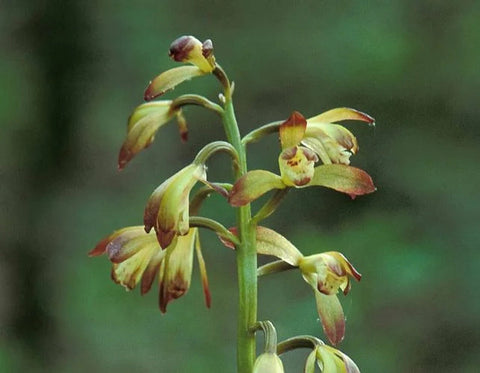

Adam and Eve Orchids - Aplectrum hyemale
The Adam and Eve Orchid (aplectrum Hymale), also called Putty Roots, is a herbaceous perennial plant, meaning it regrows every year without replanting. It is a wildflower native to Canada and the Eastern United States.
Its name comes from its characteristics of old roots, called Adam, reproducing new roots, called Eve. Its Putty Root name comes from the plant's historical use of the sticky substance covering its roots as glue to repair broken pottery.
This is an excellent plant to add to your landscaping plant because of its subtle beauty and longevity, meaning you don't have to look for a new plant every growing season to replace.
The Adam and Eve Orchid usually has a solitary basal leaf that you can see sticking up slightly from ground level at an angle. The leaf appears in late fall and disappears in spring after the plant starts to flower.
The leaf usually has an elliptical or oval shape with a rosulate arrangement. It is simple and green with a few white streaks and a purple underside. It grows between three and six inches long and one to three inches wide with no hairs on the top or bottom surface. It has entire margins, appear wrinkled, and has a pointed tip.
During spring, around May to June, the flower disappears, and the plant develops an erect stem up to 12 inches tall. At the tip of the stem, the plant produces a cluster of 7-15 widely-spaced flowers.
The showy-lipped or tubular flowers grow up to between one and three inches. They are usually light to dark brown but can sometimes be slightly purple at the base of the three sepals and petals. They have small, white, three-lobed tips that are usually purplish or magenta.
The petals usually create a wrinkled two-lipped and tubular flower, while the sepals create a triangular pattern. While the sepals usually flare and the petals forward-facing, the flowers hang down as they age.
As the flowers age and fall, the plant produces cream-to-tan capsule fruits between one and three inches long. The fruits appear in summer and usually bend downwards on the stalk.
The Adam and Eve Orchids have a regular seasonal chlorophyll production cycle because they maintain leaves only during fall and winter. With the plants above having no leaves, more light reaches the Adam and Eve Orchid, making it most productive during that time. Sweet bees or halictid bees are their primary pollinators.
What are the growing conditions for Adam & Eve Orchids
This is a great choice if you want a low-maintenance and subtle plant to add to your landscape. It grows best in rich bottomlands, on wooded slopes, along streams, and in ravine bottoms.
It develops from rounded corms mostly linked by short rhizomes. When planting it in your compound, ensure the soil is moist, occasionally wet, or has frequent standing water. If you are planting several of them, ensure ample space between them, but at most, 12 inches.
They do well in dappled sunlight exposure, meaning they should have shade from an upper canopy. However, you can expose them to direct sunlight for two to six hours daily.
You can grow the Putty roots in water, native, fairy, cottage, or children's gardens as an accent plant or specimen.
While it is easy to maintain, it could experience declined growth because of changes in the soil chemistry, acid rain deposition, deer herbivory, and the fungal species composition in the soil.
One Year Guarantee on all Perennials & Ferns. See Healthy Plant Guarantee for more details.
Color:
Green
Ships As:
Root/Bulb
Season:
Fall, Winter
Height:
12 inches
Zone:
4-8
Exposure:
Sun & Shade
Deer Resistant:
Yes
Native:
Yes




